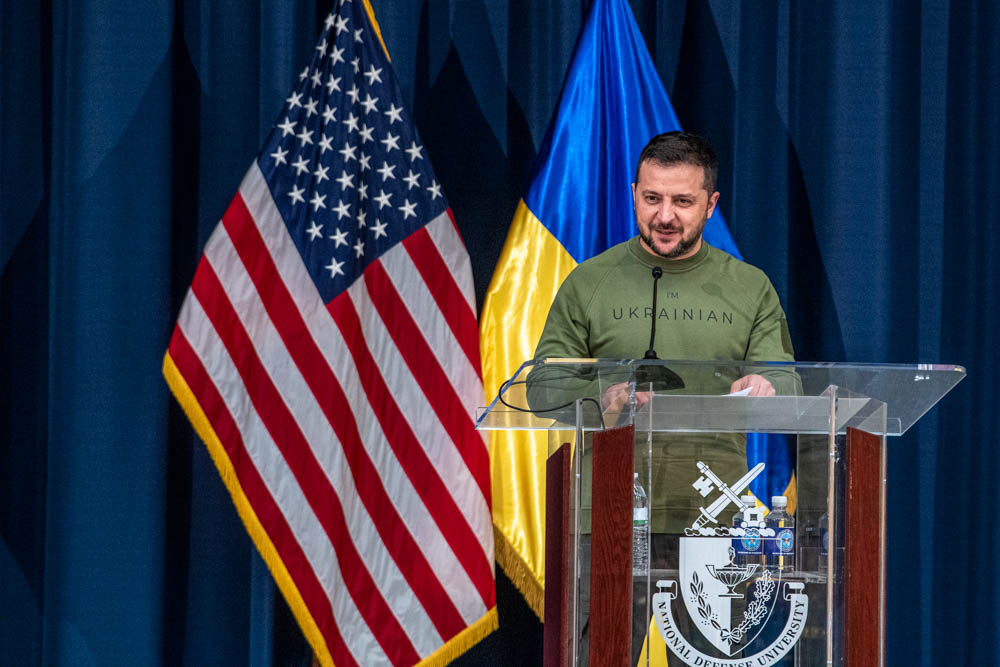Any potential Ukrainian progress in pushing back the country’s Russian invaders is already being threatened by political machinations in Washington, but if Donald Trump were to be re-elected president in November 2024, Kyiv’s position could be fatally compromised.
As 2023 drew to a close, the administration of Ukrainian President Volodymyr Zelensky must have looked with some degree of consternation at political developments in the United States, where continued funding to assist Kyiv fight off the Russian invasion, which began almost two years ago, is already stymied.
In the second week of December 2023, no doubt hoping to move the dial on this issue, Zelensky travelled to Washington, DC, and gave a speech at the National Defense University on 11 December. However, while both the US House of Representatives and US Senate passed the 2024 National Defense Authorization Act in December 2023, providing USD 841.4 billion (EUR 768.6 billion) in funding for the US Department of Defense (UD DoD), the department’s supplemental budget request – which includes more than USD 60 billion military aid for Ukraine – remains hostage to a cabal of Republican lawmakers, aligned with the Make America Great Again (MAGA) movement of former president Donald Trump, who are demanding stronger border security and are generally not conducive to delivering military aid to Ukraine.
Thus, when the US DoD announced a security assistance package for Ukraine valued at up to USD 250 million on 27 December 2023, it was the last such package that could be authorised under current legislation.
How did it come to this?
The current stance of the US Republican Party – and in particular its ambivalence to a belligerent Russia – is one that would have the Old Guard of the Grand Old Party (GOP) turning in their graves. Typically known as more hawkish and interventionist than the Democratics across the four decades from the 1970s – this is, after all, the party of Ronald Reagan, who was widely perceived, in the US at least, to have been the US president who ‘won’ the Cold War. Yet the answer to how the Republican Party has ultimately come to this position is relatively simple: Trump.
At the most basic level, it can be argued that Trump is not really even a Republican to begin with. After all, within the last 40 years he has registered as a Republican, with the Independence Party, as a Democrat and as being of no party affiliation, before returning to the Republican Party in April 2012. Before winning the 2016 presidential election, Trump, unlike every other US president before him, had never held any political office whatsoever. Thus, when Trump assumed office in January 2017, having essentially run a campaign as the antidote to the ‘Washington Swamp’, Republican politics effectively disappeared down a rabbit hole where the party’s traditional values, along with those lawmakers who still adhered to them, were drowned out by Trump’s MAGA acolytes.

Credit: Office of the President of Russia, via Wikimedia Commons
When it came to US foreign policy in relation to Russia, Trump displayed what ultimately emerged as common yet disturbing trait in praising the world’s authoritarian leaders. In a summit with Russian President Vladimir Putin in Helsinki on 16 July 2018, Trump infamously sided with Putin over the word of his own intelligence services in denying there had been any Russian interference in the US presidential election that put him into power. The late Republican Senator John McCain said at the time that “No prior president has ever abased himself more abjectly before a tyrant.”
Trump also, of course, has previous form with President Zelensky in the years prior to the Russian invasion of Ukraine. Following a whistleblower case made in August 2019 it emerged that, during a phone call between Trump and Zelensky on 25 July 2019, the US president had tried to coerce his Ukrainian counterpart into assisting in the manufacture of a damaging narrative about his 2020 Democratic presidential rival, Joe Biden, by making the release of US military aid dependent on Kyiv’s cooperation. Zelensky commendably declined to become embroiled in Trump’s machinations – which ultimately led to Trump’s first impeachment – while US military aid to Ukraine at the time was only released once Trump became aware of the whistleblower complaint.
Trump: the Teflon president-to-be?
As the United States enters the 2024 presidential election year, the prospect of a second Trump term poses a profound threat to Ukraine’s ability to continue its resistance to the Russian invasion on anything like an even playing field. Trump’s inclination to emulate the behaviour of the world’s autocratic rulers he appears to so admire – he even stated on 5 December 2023 that he would only be a dictator on “Day One” – reveals a presidential candidate likely to only double down on his defiance of democratic norms.
With regard to policy on the Ukraine war, Trump blithely stated on 16 July 2023 that he could end the conflict in a day by persuading Putin and Zelensky to “make a deal”. He offered no further details, but any such deal would almost certainly require a ceding of Ukrainian territory that Kyiv would find completely unacceptable.
Meanwhile, Trump’s tendency to ride roughshod over political convention, and indeed US law (the Trump Organisation has already been found to have committed fraud in New York), has – so far – not dented his front-runner status as the Republican presidential nominee. This is despite Trump running as the only indicted presidential candidate: he faces four felony counts in a Federal case for his efforts to overturn the 2020 election; 13 felony counts for his election interference in the state of Georgia; 34 felony counts in New York in connection with hush money payments to a porn star; and 40 felony counts in Florida for hoarding classified documents after he left office and impeding the government’s efforts to retrieve them.
Despite all of this, the US-based website ‘538’, which tracks US political polling, had Trump way ahead in Republican Primary polling as of 14 January 2024, on an average of 60.4%. His closest rivals at the time, Florida Governor Ron DeSantis and former US ambassador to the United Nations Nikki Haley, were on just 12.1% and 11.7% respectively.
Trump’s most vociferous critic among the Republican Primary candidates, former New Jersey governor Chris Christie, bowed out of the race on 10 January 2024, having supported increasing military aid to Ukraine. The remaining other two candidates that were still vying for the Republican presidential nomination, US entrepreneur Vivek Ramaswamy and former governor of Arkansas Asa Hutchinson, were on 4.3% and 0.9% respectively in the 538 poll averages as of 14 January, giving them very slim chances of securing the Republican nomination. Ramaswamy had said he favours ending US military aid to Ukraine, while Hutchinson had supported US military assistance for Kyiv.
By 22 January all of Trump’s rivals apart from Haley had quit the race, however.
In an increasingly bizarre election year, two US states – Colorado and Maine – have legislated to ban Trump from their primary ballots under the US Constitution’s 14th Amendment, determining that Trump did, in fact, engage in insurrection for his role in inciting the 6 January 2021 attack on the US Capitol Building. A final adjudication on this is going all the way to a US Supreme Court on which Trump appointed three of the nine justices.
If, despite his many legal hurdles, Trump does prevail as the Republican presidential nominee, Ukraine will have to take a long, hard look at its strategy regarding the Russian invasion while hoping that current Democratic President Joe Biden, who has steadfastly sided with Kyiv, can again beat Trump in a national presidential election.

Credit: US DoD
Among the Republican presidential alternatives should Trump’s candidacy be barred, Haley is the most pro-Ukrainian prospect, having broken from Trump in calling Putin a tyrant and stating that defending Ukraine is in the US national interest, while DeSantis has often presented a muddled view of his prospective Ukraine policy, while only appearing as a lukewarm ally at best.
Ukraine’s largest benefactor
Meanwhile, Kyiv must hope that the current impasse in the US Congress is broken and the supplemental tap dispensing US military aid is turned back on sooner rather than later.
While Ukraine does, of course, receive military aid from its European allies, the fact remains that Washington provides more funding than all of Kyiv’s other allies put together. According to a speech by US Defense Secretary Lloyd J Austin III during Zelensky’s Washington visit, the United States has so far committed more than USD 44 billion in security assistance to Ukraine compared to USD 37 billion by Kyiv’s other supporters. This means that the United States has been responsible for more than 54% of the total military aid extended to Ukraine.
Kyiv can at least take some solace from allies such as the UK holding firm and even increasing their commitments. On 29 December 2023, UK Defence Secretary Grant Shapps announced that delivery of a new package of British air defence missiles for Ukraine had commenced, while on 12 January 2024, during a visit to Kyiv, UK Prime Minister Rishi Sunak announced that the United Kingdom will provide GBP 2.5 billion (EUR 2.91 billion) worth of military funding to Ukraine in 2024/25: an increase of GBP 200 million over the previous two years.
However, while such commitments will have been graciously welcomed in Kyiv, without the lion’s share of military aid that the US has provided up until now, the Ukrainian armed forces will struggle to maintain their positions and defend Ukraine’s people and infrastructure, let alone proactively take the fight back to the invading Russians.
Peter Felstead











